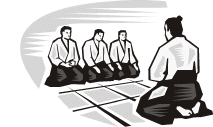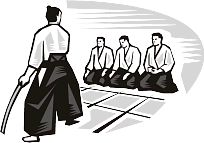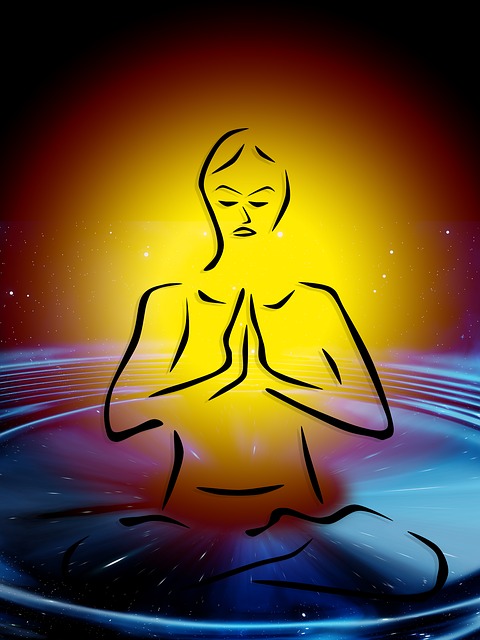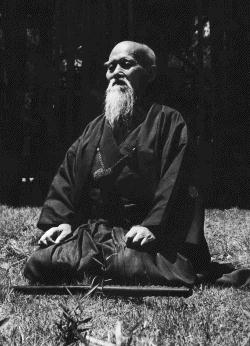We Spotlight The Aikido
of Master Kenji Tomiki

Kenji Tomiki (1900-1979) was a Japanese Aikido and judo teacher and founded Aikido Shodokan, which is often referred to as Tomiki Aikido.
His ideas of Aikido resulted in a style that combines the competitive excitement of Judo with the spiritual serenity of traditional Aikido. He was more suited than anyone to combine the disciplines of Judo and Aikido.
During the 1920's and 1930's he studied intensively with both the founder of modern Judo, Jigoro Kano, and with Aikido founder Morihei Ueshiba O-Sensei
Kenji Tomiki became an 8th Dan in Judo and Aikido.
He was born in Kakunodate, Japan, the eldest son of Shosuke and Tatsu Tomiki. When he was about 6 years old he began using a wooden sword. At the age of about 10, he began training at the local judo club.
He was active in the judo club and, on graduating from school, was awarded prizes for excellence in both academics and physical education. In November of 1919 he received his 1st dan in judo.
After graduation he became ill and took three and a half years to recover.
In 1924 he entered the Political Economics Department at Waseda University. This was the golden age of the Waseda Judo Club and he was famous for his brilliant judo skills. He was the secretary of the Student Judo Association in Tokyo and met Jigoro Kano of Kodokan who greatly influenced him.
In 1925, the year he joined Morihei Ueshiba, he had obtained 5th dan in judo. He was fascinated by Ueshiba's techniques and joined his classes.
He had begun his lifelong aikido training. In 1929, Kenji Tomiki represented Miyagi Prefecture in the first judo tournament held in front of the Emperor - this tournament became the All Japan Tournament the following year.
In 1931 he returned to his home town and took up a post at the Kakunodate Junior High School. He met Hideo Oba who began a lifelong effort to help Tomiki realise his budo ideals. Nine years later, he left and moved to Tokyo living near to Ueshiba to study aikibudo.
From 1936 until 1945 he lived in Manchuria where he taught aikibudo to the Kanton army and the Imperial Household Agency.
In 1938 he became an assistant professor at Kenkoku University in Manchukuo, taught aikibudo as part of the curriculum and gave lectures on budo. He went on to be awarded the first 8th dan in aikido.
He began his research into modernising aikido, and every summer for the next 4 years he instructed senior grades at Kodokan on a committee that worked on techniques involving distance between the two participants.
Morihei Ueshiba developed Aikido from his combat studies of Daito-ryu Aikijujutsu with Sokaku Takeda, and his spiritual studies with Onisaburi Deguchi.
Aikido focuses on harmony and non-resistance, leading to Success
Master Kenji Tomiki
and Shudokan Aikido

After returning from a three year internment by the Soviet Union, he taught both judo and aikido for many years at Waseda University.
It was there that he formulated and expanded his theories concerning both kata based training methods and a particular form of free-style fighting which would put him at odds with much of the aikido world.
In 1953 Kenji Tomiki, Sumiyuki Kotani and Tadao Otaki went to America as part of a judo delegation to instruct the U.S. Airforce in 15 states.
In 1954 he became a professor at Waseda University and led the university's Physical Education department. He published Judo Taiso.
In 1956 he published a book in English called Judo with Aikido... later called Judo and Aikido, which helped bring aikido to the West.
In 1958 he founded the Waseda University Aikido Club and became the club's first director. He published Aikido Nyumon which is still in print today. He was making progress in his research into competitive aikido.
In 1964 he became head of the department that started a special course in physical education. He published Shin Aikido Text (The New Aikido Textbook).
In 1967 he opened the Shodokan dojo exclusively for research into aikido. In 1970 he retired from Waseda University, published Taiiku To Budo (Physical Education and Budo), and presided over the first All Japan Aikido Tournament.
The foundations for competitive aikido had been laid, and in 1971 Kenji Tomiki received the rank of 8th dan in Kodokan Judo.
In 1974 he founded the Japan Aikido Association (JAA) to promote his theories. He called his style Shodokan Aikido and a honbu dojo, dedicated solely for the study of aikido, had been built in 1967 in Osaka.
In 1975 he became the Vice President of the Budo Society of Japan. In 1976 the Shodokan dojo was established in Osaka as the central dojo of the Japan Aikido Association with Tomiki as director.
In 1977 he visited Australia at the invitation of the Australian Aikido Association. In 1979 Kenji Tomiki died aged 79 years.
Kenji Tomiki is known in the judo world for his influence in the development of Kodokan Goshin Jutsu kata. His work Judo, published in 1956, is a classic. The aikido book appendix is the earliest English language text on aikido. More Here
Has this page been useful to YOU? It may benefit other people too! Please go ahead and pass it on - Share via the Link Bar below - many thanks!
Sick of the Elite Control System? Unplug from the Matrix Now!









